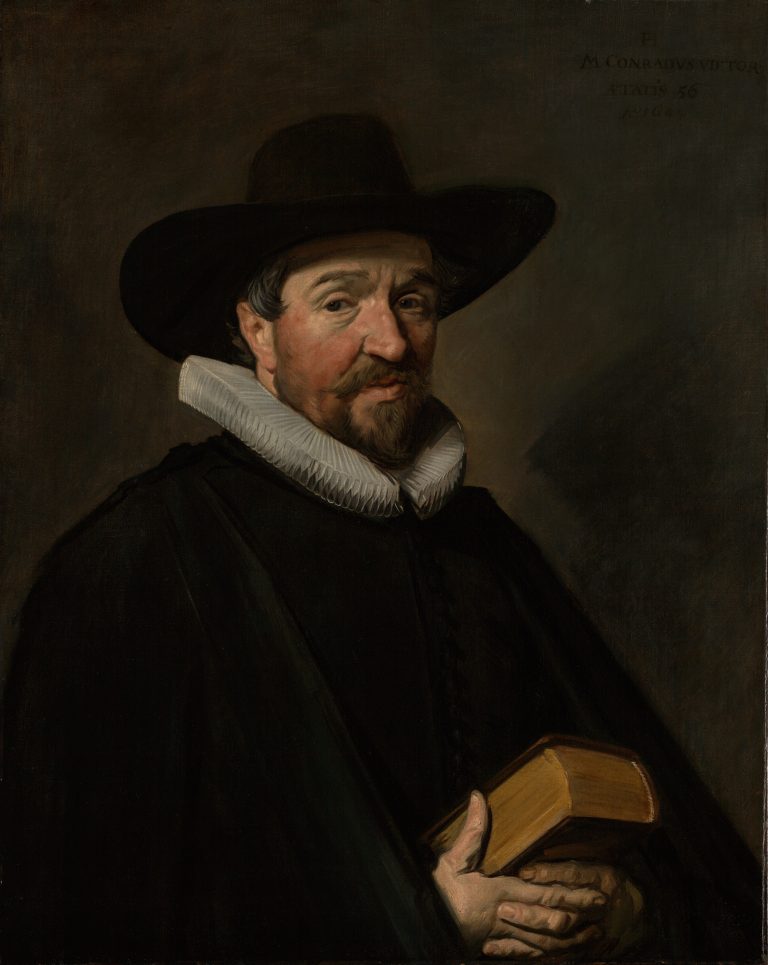Conradus Viëtor, a Lutheran preacher from Aachen, was born there in 1588 and died in Haarlem in 1657. He served the Lutheran community in Haarlem for forty years, having joined the small Lutheran community there on 1 May 1617. The humanist name Viëtor, or Vitor, is a Latinized form of the German and Dutch names for a cooper (barrel maker), so it is likely that Viëtor was born Konrad Fassbinder or Küfer. Frans Hals’s portrait, dated 1644, is inscribed with Viëtor’s name and age, fifty-six. The portrait was engraved by Jonas Suyderhoef (ca. 1613–86) shortly after the sitter’s death in 1657 (fig 1).1
Viëtor arrived in Haarlem at a significant moment in the political and religious ferment of the early seventeenth century. Until just prior to his arrival, the city council had forbidden Lutheran worship, a decree it had instituted in 1596. Although the immigration of Lutherans from Antwerp and Germany was generally regarded as advantageous for the economic well-being of the Dutch Republic, conflicts between Calvinists and Lutherans (which had been a serious problem in Antwerp before 1585) were viewed as potential threats to its stability.2 Other officially Reformed cities and towns of the Northern Netherlands similarly discouraged Lutherans and other Protestant sects from worshiping in their communities. In 1615, however, the Haarlem city council reconsidered this ban and allowed the Lutherans to open a “public” church.
Evidently, however, Viëtor was not one to calm the waters of Protestant dissent. Within months of becoming the Lutheran preacher in Haarlem (where the previous one had been shared with Lutherans in Leiden and The Hague), Viëtor entered into a contentious power struggle within his small congregation. In March 1618 the church council, the General Consistory in Amsterdam, renewed his contract only under outside pressure. By December of that year he embroiled himself in another heated issue, the right of a man to hit his wife (as had a member of his congregation), which Viëtor defended on the basis of Scripture. His position flew in the face of Dutch custom, and Viëtor found himself in trouble with the church council as well as with some of his parishioners. In 1619 he was sent to Leiden as a second preacher for six months, a cooling-off period after which the question of his return to Haarlem was to be resolved. In the end, Viëtor’s stature as a properly appointed representative of the Lutheran Church trumped the marks against him. Forty-nine women of Haarlem’s Lutheran community, in fact, wrote a petition in support of Viëtor to the General Consistory in Amsterdam, dated April 16 [1620].3
Numerous accounts testify to Viëtor’s combativeness at later dates. He frequently tested the patience of his Dutch Reformed counterparts and the city council of Haarlem. For example, during the suppression of Remonstrants (followers of the Protestant theologian Jacobus Arminius [1560–1609]) from 1618 onward, Viëtor placed himself in the vanguard of Lutheran preachers soliciting Remonstrant converts, going so far as to distribute Arminian tracts in 1624.4 He also opposed the Anabaptist argument against infant baptism in publications of 1628 and later on. Although now remembered mainly for his provocative opinions, Viëtor must have been seen by the Lutheran community in the Netherlands as an indefatigable defender of its faith during a difficult time in its history.
Hals’s portrait of Viëtor is characteristic of his work during the mid-1640s in its restrained palette and quiet composition, and in the sitter’s sober expression. The painter had a remarkable gift for characterization, and presumably the mixture of thoughtfulness, sincerity, and perhaps some anxiety that might be discerned in Viëtor’s features faithfully reflects his personality. The pose and expression found here are by no means conventional for portraits of preachers, as is clear from comparisons with the many more standardized portraits of religious figures by other Dutch artists, and Hals’s own portrait, dated 1639, of the Reformed preacher Hendrick Swalmius (Detroit Institute of Arts).5
The strong modeling of the face, despite the use of broad strokes and loose touches to suggest highlights, shadows, hair, ruddy flesh and so on, is entirely consistent with Hals’s autograph works of about the same time. The virtuoso treatment of the hands cradling a Bible seems to suggest both resolve and slight nervousness. Hals managed to evoke the different surface qualities of flesh, paper, leather and cloth with exceptional economy. The highlights and shadows in the ruff re-create its delicacy and volume; the collar’s recession is effectively conveyed at a proper viewing distance. As usual, the background plane is neutral but enlivened by the sitter’s shadow and shifting textures. The notice at the lower left on Suyderhoef’s print, “F. Hals pinxit” (“painted by F. Hals”), seems unnecessary when one appreciates the sheer quality of the painting, but, in fact, much of what Hals achieved was impossible for Suyderhoef to reproduce in his engraving.6
The portrait is thought to have been acquired by John Stuart (1713–92), 3rd Earl of Bute, and to have descended in his family until its sale in 1994. Bute was one of the great British collectors of the eighteenth century, whose Netherlandish pictures included many landscapes and genre scenes but very few Dutch portraits.7
